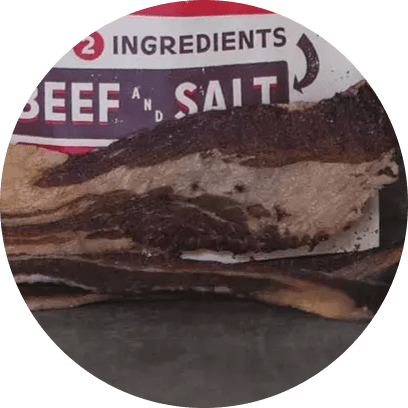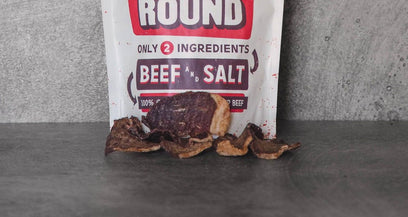THE CARNIVORE DIET BENEFITS




Have you heard the buzz around regenerative backyard gardening and looking to learn how to use regenerative agriculture in your own backyard? You’ve come to the right place!
Just picture your own backyard that was once just a patch of grass transformed into a flourishing oasis of vibrant vegetables, fragrant herbs, and thriving ecosystems. Maybe you even have a few chickens running around!
This gardening revolution offers a promise beyond its undeniable charm and personal fulfillment: to not only nourish our bodies but to preserve our land, one backyard at a time.
Read on below to discover both the benefits and challenges of regenerative farming at home, along with tips on bringing your own backyard garden to life and seeing it through to harvest.
What is Regenerative Backyard Gardening?
Let’s start with the basics - what is regenerative agriculture? More specifically, how does regenerative agriculture work? We’ll get you up to speed on the basics behind this backyard revolution below.
Defining Regenerative Agriculture
Regenerative agriculture is an approach to farming and gardening that goes beyond just “doing no harm”, like typical sustainable farming methods. Instead, it aims to actively rejuvenate and revitalize the soil, local ecosystems, and the larger environment.
This methodology is rooted in the understanding that healthy soils host a complex web of microorganisms. These microscopic allies can greatly improve soil fertility and structure when nurtured, making plants more resilient and nutritious.
We’ll talk about why this matters as we break down the regenerative farming benefits in just a moment. But first, let’s talk about the typical regenerative farming practices, and then, contrast those to traditional home gardening.
Key Features of a Regenerative Home Garden
A regenerative garden embraces diversity, unlike traditional gardens that might focus on a few favorite vegetables.
This means integrating various plants that support and nourish each other. Think tomatoes growing next to basil, beans climbing corn stalks, and marigolds dotted in between to deter pests. Our guide on regenerative farming biodiversity offers more context.
Another aspect of regenerative home gardens is avoiding tilling, which can disrupt the soil's structure and the beneficial organisms residing in it. Regenerative gardening emphasizes minimal soil disturbance, allowing the intricate web of life below the surface to thrive and benefit plant growth.
You’ll also see organic mulching on any regenerative farm. That’s because covering the soil with organic material, like straw or leaves, protects it from erosion, suppresses weeds, and provides a habitat for helpful critters. This mulch breaks down over time, enriching the soil with nutrients.
And, regenerative farmers employ more natural inputs for pest prevention and fertilizer. For example, farmers will combat bug infestations with beneficial bugs, natural pesticides, or manual removal. Similarly, farmers use compost as regenerative agriculture fertilizer rather than synthetic inputs.
How it Differs from Traditional Home Gardening
You need an understanding of conventional gardening to appreciate how profound regenerative farming at home is. Traditional home gardening, while certainly beneficial, often lacks a holistic approach to soil health and ecological balance.
It might involve frequent tilling, singular crop planting, and dependency on synthetic fertilizers or pesticides. In contrast, regenerative backyard gardening emphasizes natural processes, symbiotic relationships between plants and animals, and a proactive approach to building long-term soil health.
Gardeners who adopt regenerative practices are not just growing food - they are stewards actively participating in ecological restoration right in their backyards. Let’s progress this conversation with a thorough breakdown of the benefits of regenerative backyard gardening.
Why Try Regenerative Farming at Home?
We’re going to break down the benefits of regenerative farming at home into three different sections to show you just how profound this method of gardening can be.
Personal Benefits
Foods grown in a regeneratively managed garden are often more nutritious. The rich, balanced soil provides plants with a range of minerals, resulting in produce bursting with flavor and essential nutrients. Many gardeners notice a tangible difference in the taste!
But, this is also a good endeavor for your mental health. Numerous studies have shown that gardening can significantly reduce stress, anxiety, and depression. Engaging with the soil, tending to plants, and observing nature's rhythms can be deeply grounding and meditative.
Furthermore, you’ll develop a sense of fulfillment from your garden. You'll learn countless invaluable skills as you dive into the regenerative approach, from understanding soil health to natural pest control.
This continuous learning can be both humbling and invigorating. But, just wait till you finally get to reap the fruits of your labor - that feeling of seeing (or, more specifically, tasting) all your hard work come to fruition is unlike any other!
Ecological Benefits
It’s not just you who benefits from a regenerative backyard garden - the land does, too. Regenerative gardens are teeming with life. You'll invite a host of beneficial insects, birds, and microorganisms by promoting a diverse ecosystem.
This increased biodiversity can have positive ripple effects on local ecosystems - which you can learn more about in our guide to regenerative agriculture soil health.
You’re also doing your part to minimize your carbon footprint by operating your own backyard regenerative garden. Healthy soils with rich organic matter can capture and store carbon dioxide, playing a small but significant role in mitigating climate change right from your backyard.
This is something we dive into more extensively in our article on regenerative agriculture carbon sequestration. You can also learn about the regenerative agriculture water benefits in our blog - which we want to highlight next.
Regenerative practices like mulching and cultivating deep-rooted plants improve the soil's water retention capacity, reducing the need for frequent watering and thus conserving this precious resource.
Economical Benefits
The obvious economic benefit is that growing your food is more affordable than buying it at the grocery store. But let’s go even deeper into how a regenerative garden, in particular, is more economical than traditional gardens.
There's a reduction in the dependency on store-bought fertilizers, pesticides, and herbicides by focusing on natural, sustainable techniques. As the soil becomes more fertile with time, yields can also increase, leading to more abundant harvests and savings on grocery bills.
A well-maintained regenerative garden can not only be a source of pride but also add aesthetic and environmental value to your property. You’ll be able to command a higher price should you ever decide to sell your house.
The philosophy of 'waste not, want not' is inherent in regenerative gardening. Composting kitchen scraps, rainwater harvesting, and reusing materials for garden projects are just a few examples of how you optimize resources, thereby cutting costs. You can learn more about regenerative farming profits or why regenerative agriculture is important in general in our blog.
The Challenges of Regenerative Farming at Home
It’s paramount that you’re fully aware of the challenges that come with this style of farming before you get started.
But before we unpack some of these, just be aware - these challenges can be overcome with the right knowledge and preparation. And, they pale in comparison to the benefits. Still, here’s what you’re up against:
Space Limitations and Urban Constraints
Not everyone has sprawling acres at their disposal. Many urban dwellers grapple with small yards or even just balconies. This can make practices like crop rotation, intercropping, or maintaining livestock difficult.
Urban dwellings in particular are up against sunlight challenges. High-rise buildings and closely-packed houses might result in shaded spaces, making it challenging for sun-loving crops to thrive.
Some urban areas have zoning restrictions or homeowner association rules that can limit the kind of gardening or farming activities permissible. That being said, there are ways to overcome all these challenges.
Initial Costs and Resource Allocation
Transitioning to a regenerative approach might require an initial investment in tools, seeds, organic soil enhancers, and perhaps even workshops or books for learning. And, it’ll be a while before you’re reaping the benefits of regenerative backyard gardening.
Setting up a regenerative garden can also be time-intensive, especially in the beginning. Whether it's researching best practices, setting up composting systems, or manually weeding, patience and dedication are vital.
However, all of this will be a worthy investment when your farm starts to mature and you’re able to consistently harvest delicious, nutritious, guilt-free goodness from your garden!
Tackling Pests and Diseases the Organic Way
You need to learn about beneficial insects, companion planting, and natural repellents to combat pests, which can be a steep learning curve for some. This is why the organic approach focuses heavily on prevention.
This requires keen observation skills and proactive measures, like ensuring plant health and fostering beneficial insect populations, to avoid larger infestations or diseases.
All of this being said, it’s clear which side the scale leans in looking at the pros and cons of regenerative agriculture.
The upside is worth all the work and costs that go into getting started with regenerative farming at home. And if you agree, then let’s talk about how to use regenerative agriculture in the backyard.
How to Use Regenerative Agriculture in the Backyard
Ready to learn how to start regenerative farming? Starting regenerative farming at home can sound stressful, but it’s actually really straightforward.
We recommend starting small so you don’t get overwhelmed and adding new varieties to your garden with time. Either way, the principles of regenerative agriculture all begin with the soil - and that’s where you’ll need to start, too.
Getting Started With the Soil
Begin with understanding your soil's current condition. Consider sending a sample to a local agricultural extension for testing. This will give insights into pH, nutrient levels, and organic matter content.
From there, you’re able to take steps to optimize your soil conditions. You might decide to integrate compost, worm castings, aged manure, or a combination of these things. This not only enriches the soil but also improves its structure and water retention capacity.
Selecting the Right Plants and Crops for Your Climate
Once your soil is teeming with microbial activity you’re ready to start planting. But what should you grow? Our advice is to strike a balance between plants that are easy for beginners and foods you actually enjoy eating.
Above all else, though, you should consider which plants are native to your climate. They’re better equipped to withstand your local weather and thrive in these conditions. You can plant non-native varieties, just know that you’re fighting an uphill battle. These will require more input on your part.
It’s also imperative to coordinate your planting schedule with the seasons. This ensures that crops get optimal temperature and sunlight conditions. You wouldn’t want to plant a spring variety in the heat of summer, just as you wouldn’t plant a warm weather crop in the dead of winter.
Composting and Natural Fertilizers
You don’t use store-bought synthetic fertilizer to feed your crops. So, how do you feed them? There are two ways you can provide vital nutrients in regenerative backyard gardening:
- Home Composting: Create a compost pile or bin where you can add kitchen scraps, lawn trimmings, and other organic waste. This breaks down into nutrient-rich compost over time.
- Natural Fertilizers: Consider using seaweed, fish emulsion, or bone meal as organic fertilizers that provide plants with essential nutrients without the adverse effects of chemicals.
We’ve seen great success growing our crops in organic super soil and then top dressing with natural fertilizers as needed over a crop’s growth cycle.
Research your plants’ specific nutrient requirements and feed them accordingly, as leafy greens have much different nutritional needs than tomatoes.
Crop Rotation and Polycultures
Changing where you plant specific crops each year helps prevent soil-borne diseases and reduces pest problems. This is known as crop rotation and is something you need to make sure you prototype.
We also encourage you to look into setting up a polyculture - which is where you grow multiple crops in close proximity. This mimics natural ecosystems, confuses pests, and can lead to mutual benefits between plants.
Natural Pest Control Solutions
Even the best preventative measures fall short when you’re regenerative farming at home - your playing in Mother Nature’s arena, and there are tons of pests that are starving for your crops.
So, cncourage ladybugs, lacewings, and predatory beetles which naturally keep pests at bay. You can buy these or set up the conditions to bring them to your backyard naturally.
Implementing companion plants or cover crops for regenerative farming is another great method of naturally preventing pests. For instance, marigolds can repel nematodes, while basil might deter mosquitoes and flies.
Regular Monitoring and Adjustments
Spend time in your garden observing. Take notes on what's working and what's not, and be ready to adjust your practices.
We also encourage you to continue learning. You may want to attend workshops or join local gardening groups. Our blog has more resources on rotational grazing, regenerative cattle farming, the history of regenerative agriculture, and more to guide you along this journey.
But ultimately, regenerative farming at home is a process of trial and error. You may lose crops your first season, and that’s fine. You’ll learn from each cycle and before you know it, you’ll be proud to look out your window at a thriving backyard regenerative garden.
That being said, why not take the first step in regenerative backyard gardening today?
Wrapping Up Our Guide to Regenerative Backyard Gardening
Regenerative backyard gardening is more than just a trend - it's a movement towards sustainable living, ecological responsibility, and an intimate bond with the land right under our feet.
From nurturing the soil to embracing natural pest solutions, every step we take in this direction ensures a healthier planet for future generations.
Now that you know how to use regenerative agriculture in the backyard, what’s holding you back? It’s clear that regenerative farming can feed the world, and it starts in your own backyard.
If you want to learn more about how to support regenerative agriculture beyond your backyard, consider buying regenerative agriculture products that you can’t grow yourself - such as regenerative meat.
Our meat chips at Carnivore Snax are ethically sourced from the most elite regenerative farms in the country. They feature just two ingredients - meat and salt - making them a simple, healthy snack you can feel good about indulging in.
So, round out your regenerative agriculture diet and try our chicken chips, brisket chips, ribeye chips, beef chips, steak chips, lamb chips, and pork chips today. They’re melt-in-your-mouth good, and can inspire you to start cultivating your own products through regenerative farming at home! Taste the regenerative difference in our Carnivore Chips today.

























